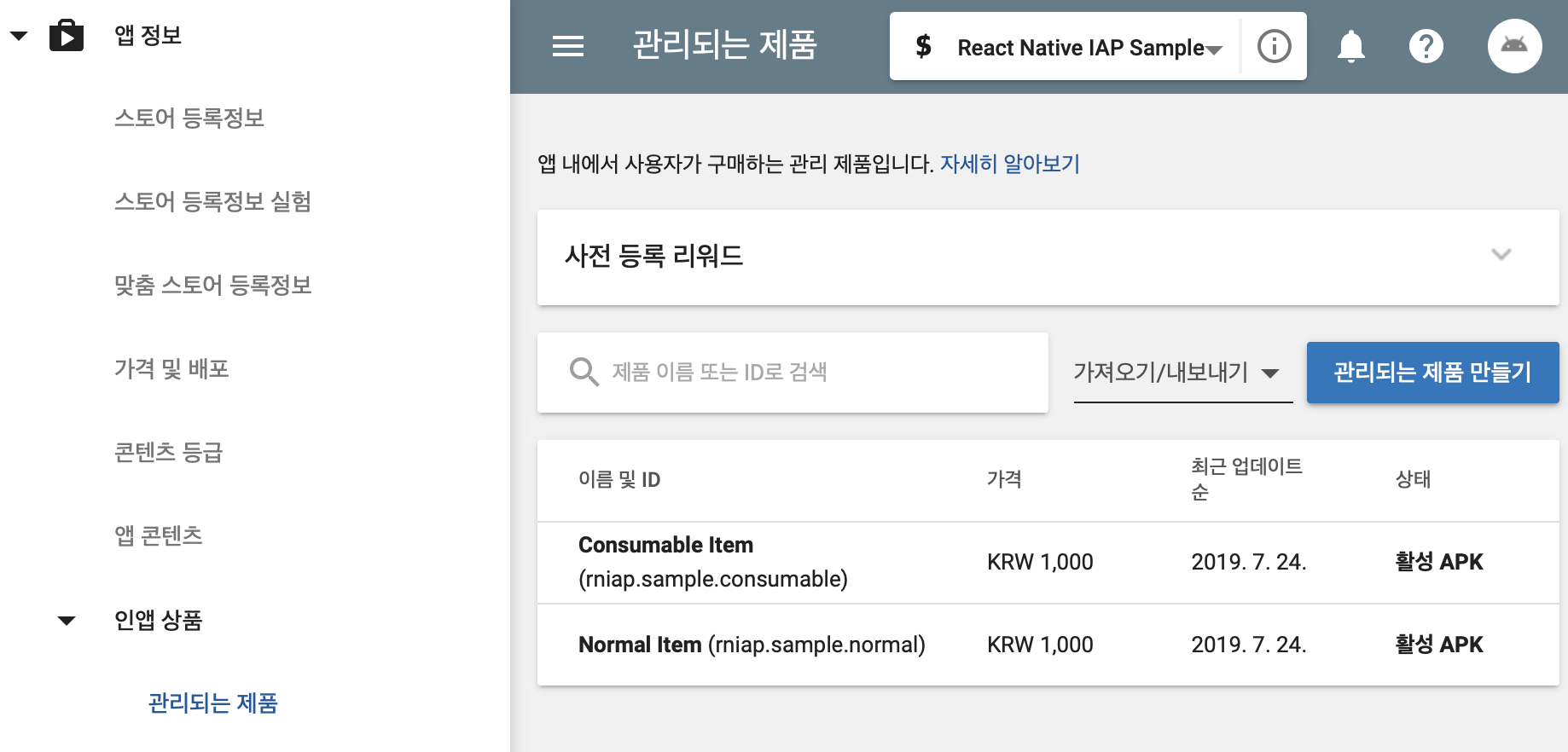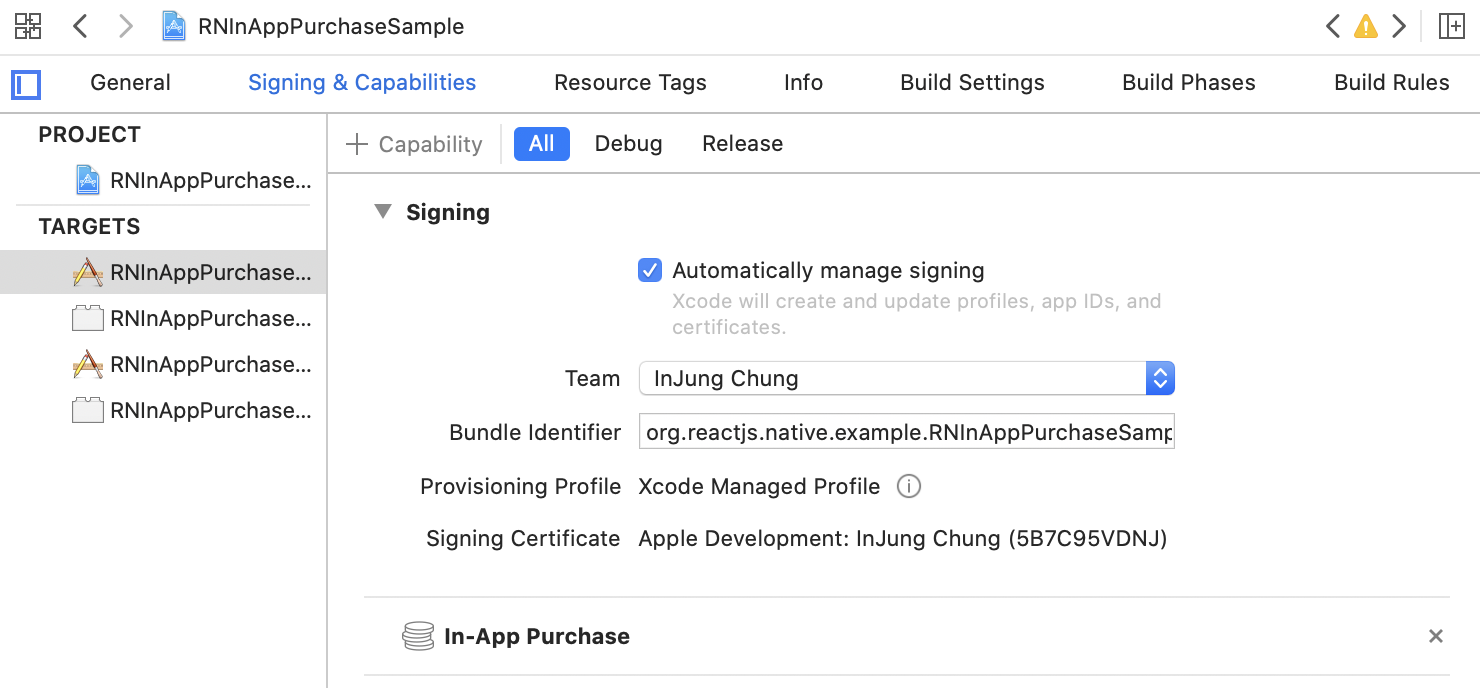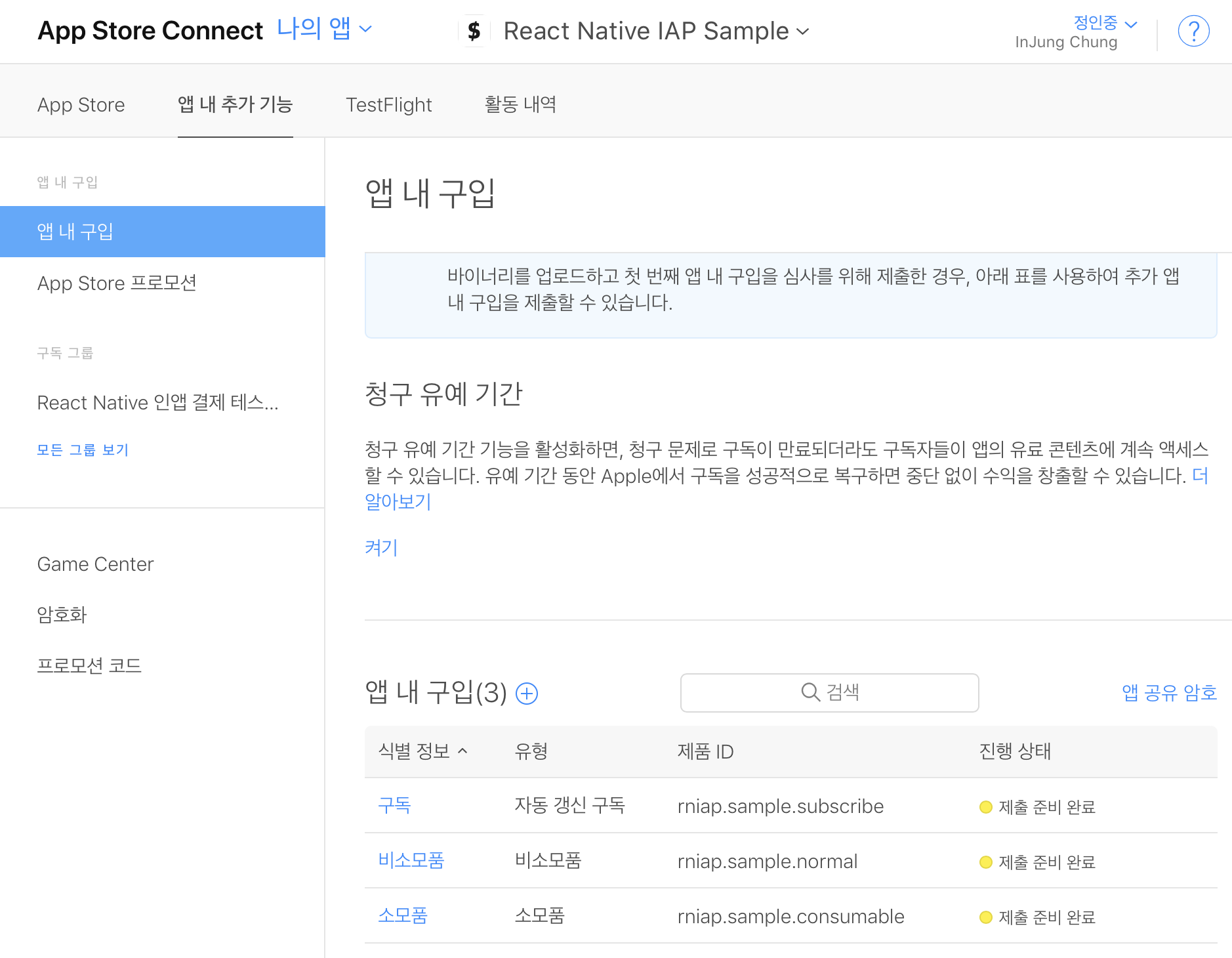react-native-in-app-purchase
Getting started
$ yarn add @mu29/react-native-in-app-purchase
# RN >= 0.60
cd ios && pod install
# RN < 0.60
react-native link @mu29/react-native-in-app-purchaseAndroid
Add BILLING permission to the AndroidManifest.xml.
<manifest
xmlns:android="http://schemas.android.com/apk/res/android"
package="com.rninapppurchasesample">
<uses-permission android:name="android.permission.INTERNET" />
<uses-permission android:name="com.android.vending.BILLING" />
...
</manifest>Create your app in the Google Play Console, and add product in the In-App Products section. Make sure set the product status to active so that you can view or purchase it.
Note that testing Android In-App Billing is only possible after uploading your APK to Alpha release or above.
iOS
Add In-App Purchase capability in the Signing & Capabilities section of the project.
Create your app in the App Store Connect, and add product in the In-App Purchases section. You may need to fill the audit information field.
Testing iOS In-App Purchase is possible on TestFlight.
Usage
See full example here. This sample can also be downloaded from the Play Store.
1. Prepare product ids
Choose the product id that you want to sell. It would be nice to have the same product id for Android and iOS.
import InAppPurchase from '@mu29/react-native-in-app-purchase';
const PRODUCT_IDS = [
'rniap.sample.normal',
'rniap.sample.consumable',
'rniap.sample.subscribe',
];2. Add Listeners
For some reasons, the purchase and fetchProducts functions are not Promise. So you need to register the onPurchase and onFetchProducts listeners.
const onFetchProducts = (products) => {
this.setState({ products });
}
const onPurchase = (purchase) => {
// Validate payment on your backend server with purchase object.
setTimeout(() => {
// Complete the purchase flow by calling finalize function.
InAppPurchase.finalize(purchase, purchase.productId === 'rniap.sample.consumable').then(() => {
Alert.alert('In App Purchase', 'Purchase Succeed!');
});
});
}
const onError = (e) => {
console.log(e);
}
InAppPurchase.onFetchProducts(onFetchProducts);
InAppPurchase.onPurchase(onPurchase);
InAppPurchase.onError(onError);After each purchase, you need to verify the receipt on your server. If the purchase is valid, call finalize function in the app. Set whether it is consumable or not as the second argument to the finalize function.
3. Configure and Fetch Products
Once you have registered your listeners, call configure and fetchProducts. Since the library will initialize billingClient only once, you can call configure, fetchProducts multiple times.
InAppPurchase.configure().then(() => {
InAppPurchase.fetchProducts(PRODUCT_IDS);
});4. Purchase Product
Call InAppPurchase.purchase with product id.
InAppPurchase.purchase(item.productId) // 'rniap.sample.consumable'5. Retry
In some cases, your app may not be able to call the finalize function even the purchase was successful. (such as poor internet connection) Purchases that are not finalized can be retrieved with the flush function. Send these purchases to the server to verify, and then call the finalize function.
InAppPurchase.flush().then((purchases) => {
purchases.forEach(onPurchase);
});Type Definitions
Type definitions of Product, Purchase and IAPError.
Product
| Property | Type | Comment |
|---|---|---|
| productId | string | - |
| price | string | - |
| currency | string | Currency code (USD, KRW...) |
| title | string | - |
| description | string | - |
Purchase
| Property | Type | Comment |
|---|---|---|
| productId | string | - |
| transactionId | string | - |
| transactionDate | string | - |
| receipt | string | Use this property to validate iOS purchase |
| purchaseToken | string | Use this property to validate Android purchase |
IAPError
| Property | Type | Comment |
|---|---|---|
| type | FETCH_PRODUCTS, PURCHASE, CONNECTION |
CONNECTION error is only occurs on Android. |
| code | number | - |
| message | string | - |
Receipt Verification
Actually this isn't something that should be mentioned in this document. However, since it's critical part of implementing In-App Purchase flow, I'll show you how I implemented it.
Client Side
const onPurchase = useCallback((result: Purchase) => {
return verifyReceipt({
variables: {
input: {
platform: Platform.select({
ios: 'apple',
android: 'google',
}),
productId: result.productId,
receipt: Platform.select({
ios: result.receipt,
android: result.purchaseToken,
}),
},
},
})
.then(() => InAppPurchase.finalize(result, true))
.then(() => Alert.alert(LocalizedStrings.COIN_PURCHASE_SUCCESS_TITLE, LocalizedStrings.COIN_PURCHASE_SUCCESS_MESSAGE))
.catch(e => Alert.alert(LocalizedStrings.COMMON_ERROR, e.message))
.finally(() => setIsLoading(false));
}, [setIsLoading, verifyReceipt]);Server Side
Here I used node-iap library.
class VerifyReceipt extends Interactor<Params, Result> {
public async perform() {
const {
user,
platform,
productId,
receipt,
language,
} = this.context;
if (!['apple', 'google'].includes(platform)) {
throw new functions.https.HttpsError(
'invalid-argument',
LocalizedStrings(language).ERROR_RECEIPT_VALIDATE_FAILURE,
);
}
return new Promise<Result>((resolve, reject) => {
iap.verifyPayment(platform, {
receipt,
productId,
packageName: PACKAGE_NAME,
keyObject: require('../../../iapServiceAccountKey.json'),
}, async (error, response) => {
if (error) {
return reject(new functions.https.HttpsError('aborted', error.message));
}
// If it's already consumed
if (platform === 'google' && response.receipt.purchase_state === 1) {
return reject(new functions.https.HttpsError(
'unavailable',
LocalizedStrings(language).ERROR_RECEIPT_NOT_FOUND,
));
}
const coin = COIN_LIST[language].find(c => c.id === productId);
// Unavailable product
if (!coin) {
return reject(new functions.https.HttpsError(
'unavailable',
LocalizedStrings(language).ERROR_RECEIPT_VALIDATE_FAILURE,
));
}
const orderId = response.transactionId;
// If it's already verified
const userRef = firestore().collection('users').doc(user.id);
const transactionSnapshot = await userRef.collection('transactions').where('orderId', '==', orderId).get();
if (transactionSnapshot.docs.length > 0) {
return resolve({
transaction: transactionSnapshot.docs[0].data() as Transaction,
profile: user,
});
}
const now = Date.now();
const batch = firestore().batch();
const receiptRef = userRef.collection('receipts').doc();
const transactionRef = userRef.collection('transactions').doc();
const transaction = {
id: transactionRef.id,
description: LocalizedStrings(language).DESCRIPTION_PURCHASE_COIN,
orderId,
amount: coin.amount,
createdAt: now,
};
batch.set(receiptRef, {
id: receiptRef.id,
productId,
orderId,
createdAt: now,
});
batch.set(userRef, {
coin: firestore.FieldValue.increment(coin.amount),
}, {
merge: true,
});
batch.set(transactionRef, transaction);
await batch.commit();
resolve({
transaction,
profile: {
...user,
coin: user.coin + coin.amount,
},
});
});
});
}
}Note the part If it's already verified. Purchases that have already been verified should also return success. Otherwise, the item will be provided multiple times when flushing.
Contributing
Bug reports and pull requests are welcome on GitHub.
License
The package is available as open source under the terms of the MIT License.






